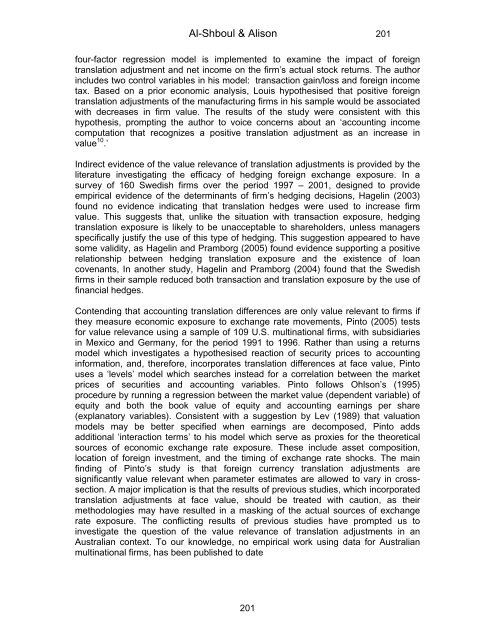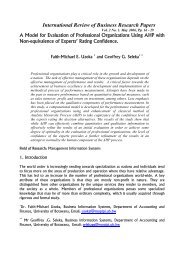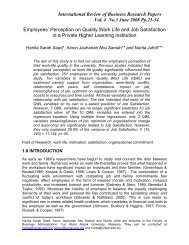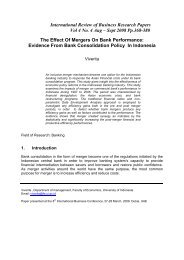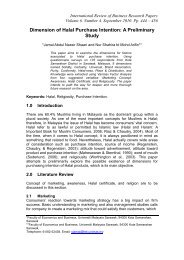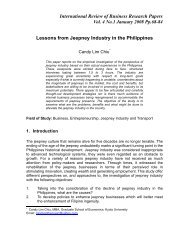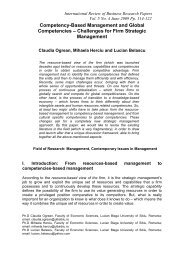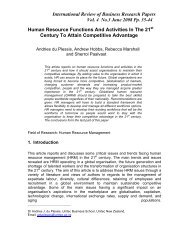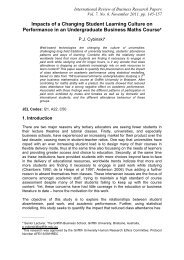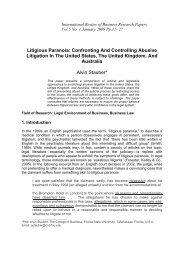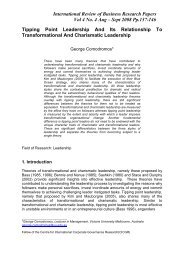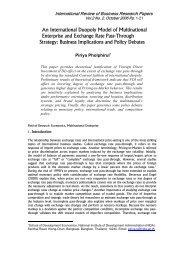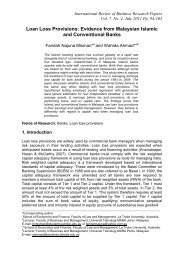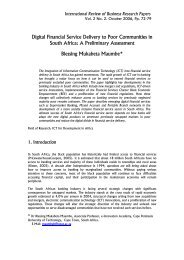Translation Exposure and Firm Value, Evidence From Australian ...
Translation Exposure and Firm Value, Evidence From Australian ...
Translation Exposure and Firm Value, Evidence From Australian ...
Create successful ePaper yourself
Turn your PDF publications into a flip-book with our unique Google optimized e-Paper software.
Al-Shboul & Alison 201four-factor regression model is implemented to examine the impact of foreigntranslation adjustment <strong>and</strong> net income on the firm’s actual stock returns. The authorincludes two control variables in his model: transaction gain/loss <strong>and</strong> foreign incometax. Based on a prior economic analysis, Louis hypothesised that positive foreigntranslation adjustments of the manufacturing firms in his sample would be associatedwith decreases in firm value. The results of the study were consistent with thishypothesis, prompting the author to voice concerns about an ‘accounting incomecomputation that recognizes a positive translation adjustment as an increase invalue 10 .’Indirect evidence of the value relevance of translation adjustments is provided by theliterature investigating the efficacy of hedging foreign exchange exposure. In asurvey of 160 Swedish firms over the period 1997 – 2001, designed to provideempirical evidence of the determinants of firm’s hedging decisions, Hagelin (2003)found no evidence indicating that translation hedges were used to increase firmvalue. This suggests that, unlike the situation with transaction exposure, hedgingtranslation exposure is likely to be unacceptable to shareholders, unless managersspecifically justify the use of this type of hedging. This suggestion appeared to havesome validity, as Hagelin <strong>and</strong> Pramborg (2005) found evidence supporting a positiverelationship between hedging translation exposure <strong>and</strong> the existence of loancovenants, In another study, Hagelin <strong>and</strong> Pramborg (2004) found that the Swedishfirms in their sample reduced both transaction <strong>and</strong> translation exposure by the use offinancial hedges.Contending that accounting translation differences are only value relevant to firms ifthey measure economic exposure to exchange rate movements, Pinto (2005) testsfor value relevance using a sample of 109 U.S. multinational firms, with subsidiariesin Mexico <strong>and</strong> Germany, for the period 1991 to 1996. Rather than using a returnsmodel which investigates a hypothesised reaction of security prices to accountinginformation, <strong>and</strong>, therefore, incorporates translation differences at face value, Pintouses a ‘levels’ model which searches instead for a correlation between the marketprices of securities <strong>and</strong> accounting variables. Pinto follows Ohlson’s (1995)procedure by running a regression between the market value (dependent variable) ofequity <strong>and</strong> both the book value of equity <strong>and</strong> accounting earnings per share(explanatory variables). Consistent with a suggestion by Lev (1989) that valuationmodels may be better specified when earnings are decomposed, Pinto addsadditional ‘interaction terms’ to his model which serve as proxies for the theoreticalsources of economic exchange rate exposure. These include asset composition,location of foreign investment, <strong>and</strong> the timing of exchange rate shocks. The mainfinding of Pinto’s study is that foreign currency translation adjustments aresignificantly value relevant when parameter estimates are allowed to vary in crosssection.A major implication is that the results of previous studies, which incorporatedtranslation adjustments at face value, should be treated with caution, as theirmethodologies may have resulted in a masking of the actual sources of exchangerate exposure. The conflicting results of previous studies have prompted us toinvestigate the question of the value relevance of translation adjustments in an<strong>Australian</strong> context. To our knowledge, no empirical work using data for <strong>Australian</strong>multinational firms, has been published to date201


